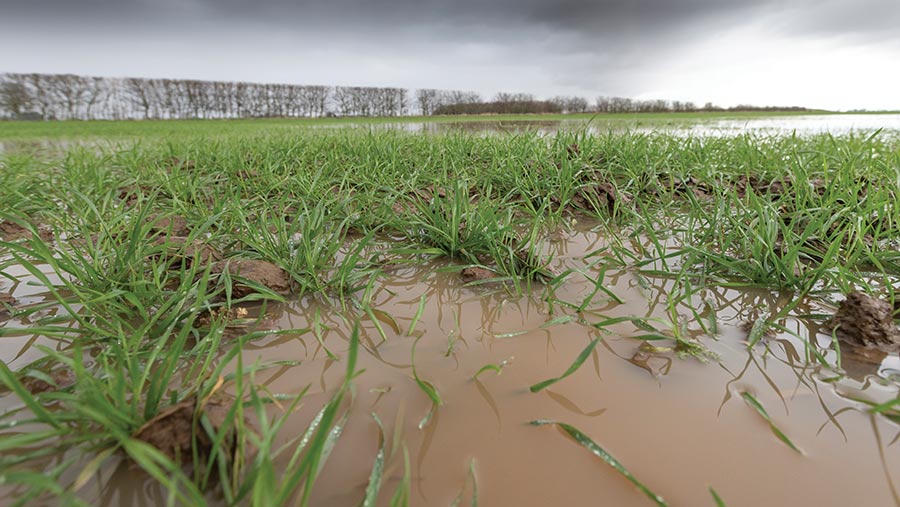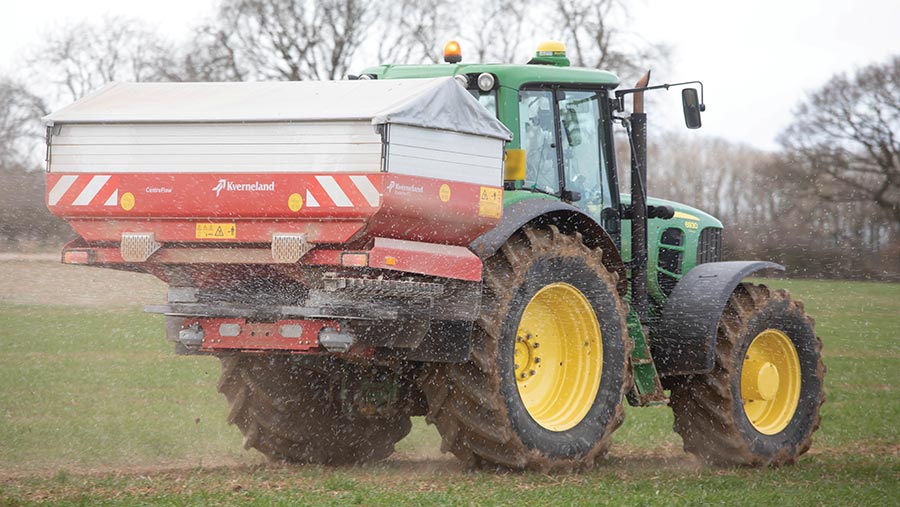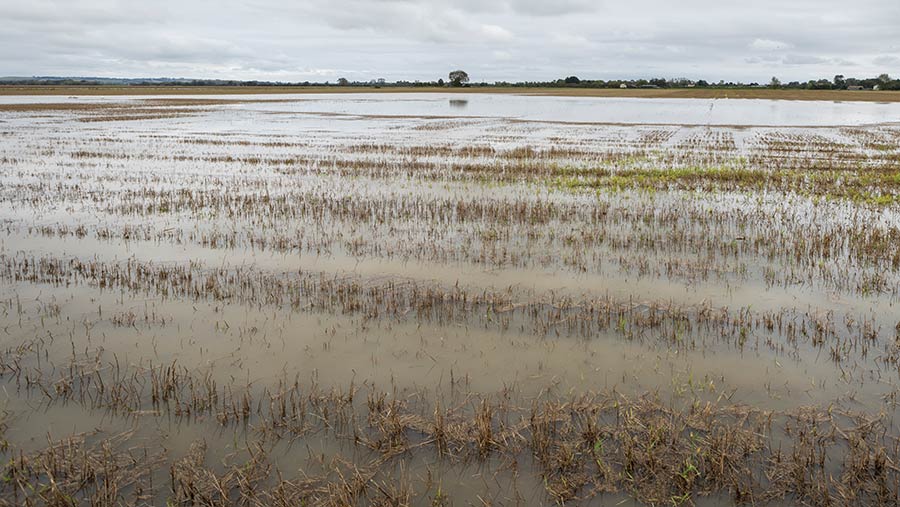How arable farmers can turn things around this spring
 © GNP
© GNP It may feel like doom and gloom at present, as any rare dry days are predictably followed by another spell of rain – a cycle that has limited field work since mid-October.
However, three members of the Association of Independent Crop Consultants (AICC) believe there are reasons to be positive, given the right management choices in the coming weeks.
West Country rain
Covering Wiltshire and Gloucestershire, Wessex Agronomy’s Jamie Armstrong says aside from a brief respite in June, it has rained every week since the beginning of March last year.
Apart from those on free-draining chalks, this has not put any of his clients in the best position, particularly those on heavier soils to the west.
See also: Which spring barley varieties to consider for 2024
Those with clays, silts or greensands have seen soils reach field capacity and any winter cereals drilled just before the mid-October deluge have struggled in saturated soils.
Waterlogging has resulted in reduced plant populations, together with the highest slug pressure seen for many years, despite multiple applications of slug pellets.
Jamie says some winter crops have already been written off and will be redrilled in the spring. Those on a knife edge will be monitored for yield potential and treatment tailored accordingly.

© Tim Scrivener
Nitrogen and fungicides
“We will be looking at nitrogen recommendations for winter wheat on a field-by-field basis and if there aren’t the tillers to hold on to, then there won’t be a requirement for higher rates.
“Similarly on fungicides, we will do our best to keep costs to a minimum in backward crops at T1, avoiding the heavy-lifting products until T2, if they are used at all. Of course, that will depend on disease pressure, and we will adapt to the season,” he explains.
Jamie points out that with margins for harvest 2024 under pressure, cutting phosphate and potash fertiliser use is another means of reducing input costs this spring.
Soil analyses and organic manure history will be considered and, where deficient, applications will be made.
“For soils higher than index 2, I’d be comfortable not applying any fresh potassium and potentially make up for it the following season when crops have more potential,” he says.
Winter crop area
He estimates that some 70% of the planned winter crop area is in the ground. What to do with the remaining 30% is a conundrum, given the lack of reliable options.
Those who already grow spring barley can use home-saved seed, avoiding issues with tight certified seed supply, and may increase their area.
However, Jamie is steering most clients away from spring wheat because of the ergot risk, particularly where land is infested with blackgrass.
“Much depends on how early you can get drilling. The undrilled areas are all on heavy land and spring wheat should be drilled in late February to maximise potential, so it may not be a viable option if it doesn’t dry out,” he explains.
If farms are fortunate enough to be close to an anaerobic digester, spring oats could be a useful option.
Where Countryside Stewardship schemes are running, this can work in conjunction with certain options such as AB14 – low-input harvested cereal, or AB7 – whole-crop cereals.
While crops such as spring linseed are viable if grown well, Jamie points out that the shift of spring beans from a minor to major crop has seen the loss of a handful of extension of authorisations for minor use (Eamus), limiting pre-emergence herbicide options and thereby increasing costs.
“Achieving consistent yields from spring break crops is often tricky, and I believe changing weather patterns are adding to this challenge,” he concludes.

© GNP
Eastern perspective
Some areas of the East have been hit hard by wet weather, particularly in areas of Suffolk and the low fens.
Norfolk-based adviser Craig Green says that compared with these worst-hit areas, his clients have fared relatively well, but even so only 75% of their planned winter crop seed made it into the ground before Christmas.
Most undrilled land was planned winter wheat after potatoes, sugar beet or maize crops delayed by the major deluge on 11 October. The rest was heavier, freshly moved soil that took significant rain and hasn’t dried out since.
Seed scarcity
Craig says economically, spring barley is the best option for undrilled ground in his area, but short seed availability across Europe means little chance of securing the best varieties at home or via imports.
This limits any increase in spring barley area to farms that already grow the crop, as they can used home-save seed. Defra rules restrict home-saved seed use to the holding on which it was grown.
“I’ve had quotes for spring wheat seed at almost £700/t, making it unviable, and sugar beet and maize areas are likely to remain static,” he explains.
This is pushing growers towards fallow or non-cash crop routes within the Sustainable Farming Incentive (SFI), if they weren’t already considering it.
The AHL2 winter wild bird food is a fixed option that brings in £732/ha/year over a three-year agreement, and guidance recommends sowing it between March and June.
The effect of this on a rotation would need to be carefully considered in terms of herbicide choices being limited, but may suit the smaller or outlying fields of a farm.
A one-year NUM3 legume fallow is a good choice. It will return £593/ha when left in the ground for 12 months, fixes nitrogen and adds organic matter, and allows prompt entry back to first wheats.
“They are both low-input and will pay quarterly over the course of the agreement, so can help spread a bit of cashflow over the year,” Craig says.
“It’s worth seeking expert advice if you need more detail on options and register interest for the SFI scheme.”
Cash crops
Looking at cash crops, there are some important lessons to remember from 2019-20, when a similarly wet drilling campaign disrupted rotations, he says, and some are still not entirely back on track.
This is because many growers opted for spring barley or spring wheat, both of which prevented them from going straight back into first wheat the following year.
To get around this, he suggests opting for spring oats on lighter land where grassweed infestations are relatively low, as herbicide options are limited.
There are currently attractive buy-back contracts on offer for milling oats, with ADM topping the list.
Legumes also offer a rapid return to first wheat and additional rotational benefits outside net margin, including some residual nitrogen for the following crop.
Out of spring bean and spring combining peas, the latter offers the better returns, with strong demand seeing good buy-back contracts being offered by most merchants.
“They can be difficult to grow, with lodging an issue, but with a well-managed seed-bed they should be fine at harvest,” says Craig.
Winter cereals
Surviving winter cereals are looking sorry for themselves sat in wet soil, but he believes a couple of dry weeks will soon see them pick up, and growers should plan to get the right quantity of key nutrients on to help them along.
In wet soils, rooting is likely to be shallow and this could compromise drought tolerance later in the spring.
“There will be less nitrogen and other water-soluble nutrients such as potash and magnesium in the soil, so if you can give them a bit of help early in the season, they will develop a bigger root mass and make better use of water and fertiliser later on.”
He recommends starting nitrogen applications as soon as conditions allow in February, and taking a little-and-often approach using four main splits instead of three to help improve uptake efficiency.
If using urea-based liquid fertiliser, he suggests using a nitrification inhibitor to slow nitrate release and allow compromised roots systems time to absorb it, with Limus performing well in recent on-farm trials for both nutrient loss reduction and yield.
“Fresh potassium should be applied based on soil indices, and a foliar magnesium sulphate product will provide some magnesium and sulphur to aid rooting,” says Craig.
North: Intense rainfall
Covering East and South Yorkshire and down into Nottinghamshire, Arable Alliance adviser Robert Burgess says his clients recorded about 20% more rainfall than average during the 2023 calendar year.
This isn’t a huge increase, but much of the excess fell with high intensity in mid-October, with 100-120mm measured in just three days on many farms across the region.
Robert says before this heavy rain, winter barley crops were drilled in good conditions and, although they look hungry now, they have fared reasonably well.
However, winter wheat hasn’t coped so well. About 70% of his winter wheat area was drilled before the deluge, but since then about 20% has been lost.
Losses have been caused by seed rotting in the ground, and it has been a challenge to keep up with molluscicide applications to prevent terminal slug damage.
Poor soil conditions
“Soil conditions are now quite poor, with fields sat very wet and capped in places. Some of the earliest-sown wheat is looking OK, but crops emerging as the heaviest rain fell are struggling.”
Despite the likely glut of spring barley in the market and the quantity of dressed winter wheat seed in the shed, Robert is still encouraging growers to plant as planned when conditions allow.
With most growers majoring on milling wheat Skyfall across his area, it can be sown safely up to the end of February.
Of the feed varieties, Champion also offers a wide sowing window, with a mid-February cut-off.
“Where late winter wheat drilling is not an option, spring crops will be selected based on soil type and suitability within each farm’s rotation,” adds Robert.
Winter fallow
Maintaining a winter fallow with a subsequent summer cover crop is on the list of alternative options, using species such as oil radish and mustard to improve soil structure before establishing first wheat into a good seed-bed next autumn.
These deep-rooting species provide adequate biomass and can be complemented by vetch to fix nitrogen in the soil.
“People are also looking at a legume fallow as part of a Sustainable Farming Incentive agreement, but the problem is grassweeds and restrictions on what you can do to control them.
“With a standard cover crop, you have a bit more flexibility, so we can destroy it before blackgrass and ryegrass goes to seed and get a clean start for the following crop,” explains Robert.
He adds that the sugar beet area will stay relatively static due to finite availability of quota, despite the resolution of the price negotiations, but maize could be increased where land is suitable and an end market is secured.
“Maize isn’t an option on heavier land due to the late harvest, and that’s where most of the problem has been.
“However, maize could be an alternative to spring barley on lighter land and provides a better margin.”
A bigger area of spring beans could be attractive to those familiar with the crop, but Robert warns that beans can be inconsistent compared with other spring options.
“If home-saving spring bean seed, make sure you get stem nematode, ascochyta and germination tests done to ensure what you are planting will establish well.”
A wet year for many
The UK saw 11% more rain than average in 2023, with a provisional figure of 1,290mm, according to the Met Office.
The year included the UK’s sixth-wettest March, sixth-wettest July and joint sixth-wettest October.
Much of the country was wetter than average last year, with Northern Ireland having its third-wettest year on record, says the Met Office.
Northern Ireland provisionally recorded 1,399mm of rain – 21% more than average.
England had its sixth-wettest year on record with 1,045mm, or 20% more than average. Some parts of the UK recorded one-third more rainfall than normal.

